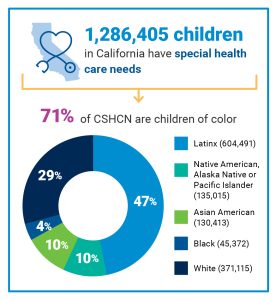“What makes me smile is my motivation for continuing to help my son with special needs and learning how to help him better and with all of my love.” — Mom with son with Autism
“I would recommend telehealth to other parents because it does save a lot of time especially when you have multiple children and they are not allowing you to bring siblings into appts so don’t have to looks for daycare for the other kid or stress out so just for comfort of it” –Mother of daughter with Down syndrome
“I don’t drive, so I always had to find transportation to take my child to the doctor. With telehealth, I didn’t have to do that.” – Mom with a daughter who has ADHD
“It would be great if we could have more time for telehealth appointments and more room for parents to ask questions during appointments.” –Mother of daughter with Down syndrome
“It was difficult because I wasn’t taught how to use computers or technology. My kids helped me. But it was a challenge. My screen would freeze. My internet would drop because there were so many people using the internet at the same time.” — Mother with son with a speech delay
“Policymakers should think about all types of cases — there are so many needs — that they don’t lose the focus for children who have more specific and special needs.” — Mother of daughter with Dyslexia
With the release of the report, Telehealth and Children of Color with Special Health Care Needs: Lessons from the Pandemic, The Children’s Partnership centers the resilience and lived experiences of these and other families of color with children who have special health care needs from across California, putting forth learnings and systemic policy recommendations rooted in their voices in order to make our health care system more equitable by responding to their needs.
Telehealth has been a critical tool to increase access to care for children with special health care needs. However, over the last two years of the pandemic, the dramatic shift towards telehealth provided an opportunity to understand whether telehealth has lived up to its promise of connecting children with the services they need, specifically for the state’s nearly 1 million Latinx, Black, Native American, Asian American, and Pacific Islander children of color who have special health care needs. And if not, what can be done about it.

Despite children of color making up over 2 in 3 of the state’s children who have special health care needs, there is limited research and recommendations that center their unique experiences and challenges. Through community listening sessions, surveys and conversations, The Children’s Partnership hosted 85 families of color of children with special health care needs from across California and our new report shares key learnings and recommendations grounded in the experiences of and reviewed by these families. The report offers an opportunity to amplify how community-centered research and policy-making is key to ensuring representation and equity in health care.
Community input must guide our work. Communities know best the solutions to the challenges they face. We invite, engage and design solutions and co-produce knowledge in partnership with them, knowing policies will be strongest if solutions come directly from impacted communities themselves. ~ TCP Strategic Plan |
Through this research, we gained unique insights, referred to as “Learnings” in the report, into the experiences of families of children of color with special health care needs during pandemic shutdowns:
-
- Telehealth helped keep children of color with special health care needs connected to health services during the pandemic.
- Telehealth addressed some challenges children of color with special health care needs typically face when accessing care, including lack of transportation, long wait times for appointments, and lack of child care.
- Families indicated a strong interest in the option of having telehealth appointments for their children while at the same time noting that telehealth did not adequately address all special health care needs.
- Families continued to face systemic challenges that limited their ability to access care for their children using telehealth, including digital, educational, language and cultural barriers.
- The pandemic caused instability, compounding and creating mental health issues and challenges for children of color with special health care needs and their families.
We also put forward recommendations for systems that interact with children of color with special health care needs that are rooted in family voice and supported by The Blueprint for Change: A National Framework for a System of Services for Children and Youth with Special Health Care Needs.
Systems that serve children of color with special health care needs should:
-
- Treat families of color with CSHCN as experts of and center them in their children’s care.
- Allow CSHCN of color and their families to use multiple telehealth modalities to access health care.
- Ensure families of color with CSHCN are able to have a telehealth visit using the technology that is accessible and comfortable to them, including by phone, text or video.
- Address telehealth access issues by increasing the number of community sites where children can have a telehealth visit, including their schools, early learning and child care centers.
- Integrate community members who reflect the experiences of families of color with children who have special health care needs, like peers, community health workers, and promotores, into the health care system to help families understand how to use and navigate telehealth, as well as provide services to families using telehealth.
- Ensure telehealth is racially, culturally and linguistically concordant, including by providing more time for bilingual appointments.
- Increase access to mental health services using telehealth.
Policymaking must begin by listening to the needs, priorities and suggestions of those directly impacted – a lesson made more prominent during this pandemic. As we continue our work to recover from the ongoing pandemic, improving the delivery of care for marginalized communities must begin with asking such communities what more can be done to meet their needs. Alongside the wisdom and resilience of families of color of children with special health care needs, TCP looks forward to advancing these recommendations in advocacy to improve care delivery for all children.
Learn more at the upcoming webinar on September 28 from 4-5:30 p.m. PST. Register here and join us in the work.
Special thanks to Aerin Scalco, our Summer 2022 intern, for her contributions to this blog.

